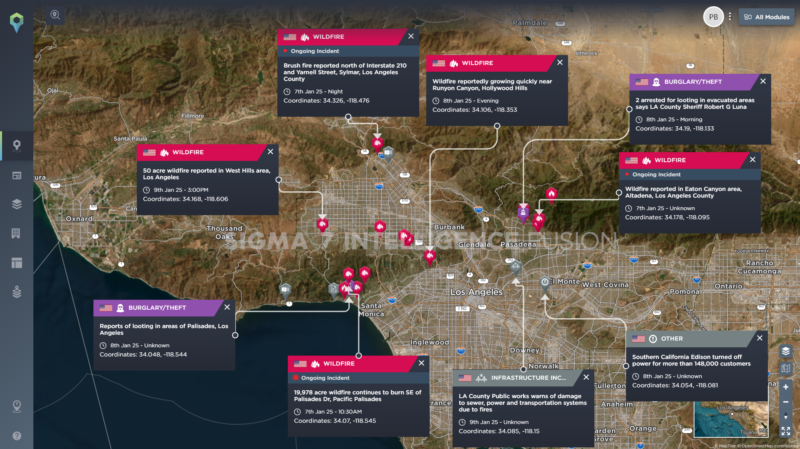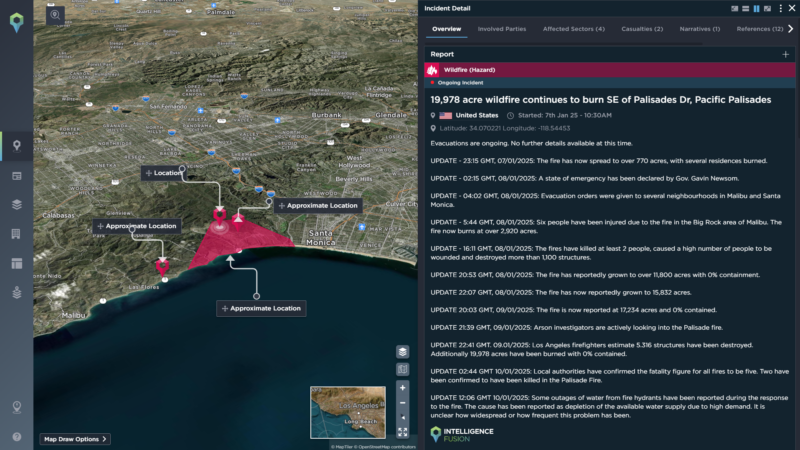Time of latest information: January 10th, 2025, 04:06 PST
Beginning on Tuesday, January 7th, 2025, a series of devastating wildfires have ripped through parts of Los Angeles, rapidly increasing in size to create what looks set to be one of the most severe wildfire events in years – months before the beginning of the typical California wildfire season.
These wildfires, driven by fierce Santa Ana winds and prolonged drought conditions, have caused significant disruption to lives, businesses, and infrastructure. As of the time of writing, the fires continue to burn, causing ever increasing Natural Catastrophe (NatCat) losses and underscoring the urgency for effective response and recovery strategies.

A selection of incidents related to the California wildfires [image: Sigma7 Intelligence Fusion]
The Situation So Far
Over the past few days, several major wildfires have burned across tens of thousands of acres across Los Angeles County, with widespread impacts. At least 10 people have been killed, thousands of structures have been destroyed, and billions in NatCat losses are expected. At the time of writing, five of these continue to burn:
- Palisades Fire: The largest of the blazes, covering nearly 20,000 acres, is 6% contained. Some 5,300 structures have been destroyed, making it the most destructive fire in Los Angeles history. Thousands of residents in Pacific Palisades have been evacuated, and damage to homes and businesses is extensive.
- Eaton Fire: Spanning nearly 14,000 acres, this fire has destroyed 5,000 structures, and forced evacuations for over 40,000 people in Altadena and surrounding areas. As of Thursday night, it was 0% contained.
- Hurst Fire: Burned 771 acres with firefighters beginning to achieve containment, currently at 37%. It continues to threaten nearby residential and commercial properties.
- Lidia Fire: Impacting 390 acres, it is currently 75% contained.
- Kenneth Fire: A new blaze, covering nearly 1,000 acres, erupted on Thursday in the Woodland Hills area. Authorities quickly detained a man on suspicion of arson. Evacuation orders were later downgraded, and forward progress of the fire was stopped, officials said.
- Earlier Sunset, Woodley and Olivas fires have been contained.

The latest on the Palisades fire as at 04:06am PST (image – Sigma7 Intelligence Fusion)
Officials have pointed to high winds and drought in the area as key reasons for the fire’s large impact. A warm summer and lack of rain in recent months has made vegetation very dry and easy to burn. Added to this are the powerful, erratic winds which hit northwest Los Angeles, with gusts hitting up to 100mph in some places, causing the fires to spread quickly and change direction unexpectedly, and complicating firefighting efforts. These strong winds are set to last through Friday, making containment difficult.
The fires have disrupted daily life across the region. At the time of writing, nearly 180,000 residents are under evacuation orders, with an additional 200,000 under evacuation warnings, while key infrastructure has been damaged. Communities such as Altadena have been advised to only drink bottled water until further notice due to water contamination risks. Hundreds of thousands of homes and businesses remain without power in California, while poor air quality affects millions. Meanwhile, more than 20 arrests have been made on suspicion of looting over the last few days.
The Eaton fire has caused widespread destruction and claimed multiple lives. At the time of writing the fire is 0% contained (video – @3_di.chi via Ruptly)
Beyond the immediate fire zones, supply chains will likely have been interrupted as transportation routes are rendered impassable. This could cause significant operational delays for businesses across multiple sectors, from retail to logistics. Safety and air quality concerns could lead to widespread business closures and impact their ability to operate. With the economic toll expected to run into billions of dollars, California’s insurance market—already under strain—faces significant challenges in meeting claims from this disaster.
According to preliminary estimates from AccuWeather, this is already one of the worst wildfire episodes in California history, creating economic losses ranging from $52 billion to $57 billion, including both insured and uninsured losses. Almost 10,000 structures have been destroyed by the Palisades and Eaton Fires, and that number is expected to increase.
What to Do Next: Managing and Recovering Losses
The California wildfires are expected to cause billions in losses from widespread damage, as seen in this video from Pasadena (video – Chris Long via Ruptly)
Once you and your people are safe, the next priority is navigating the path to recovery. Here are actionable steps to ensure your losses are documented effectively and recovery is maximized:
- Document the Damage:
- Begin cataloguing property damage immediately, using photographs, videos, and written descriptions.
- Maintain a detailed inventory of damaged assets, including buildings, equipment, and inventory.
- Review Your Insurance Policy:
- Familiarize yourself with policy terms, particularly those covering property damage, business interruption, and professional fees.
- Establish a preliminary total gross loss estimate using standard insurance categories such as debris removal, cleanup, and lost production.
- Engage Expertise:
- Collaborate with forensic accountants, engineers, and adjusters to prepare a thorough and well-documented claim.
- Ensure all financial documentation, including payroll records and operational data, is organized and audit-ready.
- Communicate Effectively:
- Coordinate with your insurance broker and adjusters to facilitate a smooth claims process.
- Keep stakeholders informed, including employees, suppliers, and customers, to maintain transparency and trust.
For more information on loss recovery, download our free NatCat Claims Guide here:
Preventative Measures for the Future
While immediate recovery is the focus, it is critical to consider long-term strategies to build resilience against future wildfire risks. Steps to enhance preparedness include:
- Conducting site-specific wildfire risk assessments to identify vulnerabilities.
- Implementing defensible space strategies, such as clearing vegetation around properties and using fire-resistant landscaping.
- Developing and practicing emergency response plans, including evacuation drills and communication protocols.
- Investing in fire-resistant materials for building upgrades and critical infrastructure.
- Establishing real-time monitoring systems to track fire risks and enhance response capabilities.
By taking these measures, businesses can better protect assets, minimize future disruptions, and ensure long-term operational continuity.
For more information on NatCat risk mitigation, download our free brochure here:
Learn more about NatCat Risk Engineering

A selection of incidents related to the California wildfires (image – Sigma7 Intelligence Fusion)
The California wildfires have already caused significant personal and financial devastation, and our thoughts are with everyone impacted by the disaster. With the fires continuing to burn, the first priority for everyone right now should be the safety of the people affected.
When the fires have been contained, and you and your people are safe, it will take time to understand the scale of the losses that have been left behind. Sigma7 will be here to help.
For those who have not been impacted by the California wildfires, they still serve as a reminder of the significant risks posed by natural disasters. NatCat losses are mounting year-on-year, with the increasing frequency and severity of natural disasters underscoring the importance of preparedness and recovery planning.
By following structured claims processes and implementing resilience strategies, businesses can navigate the challenges of financial recovery effectively. Proactive measures to address future risks will be essential in maintaining sustainability and continuity in an unpredictable climate landscape.
For more resources and expert guidance on disaster recovery and risk mitigation, contact Sigma7 today.






